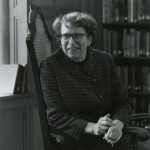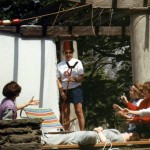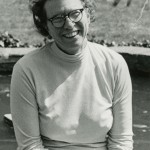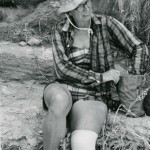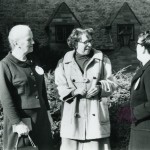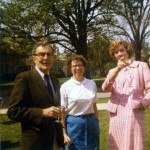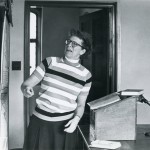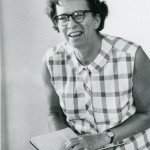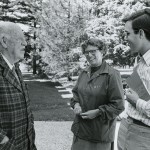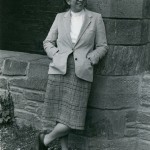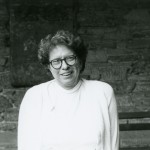As you can see from the description in the program*, Mabel’s scholarly activity was largely archaeological, yet ironically she always stressed she was not an archaeologist. I used to assume she meant simply that she enjoyed texts as much as material objects, but now that I’ve looked a bit at her three publications of material excavated in the Athenian Agora I see more to it. All three books (weights, graffiti, ostraka) are collections of objects with writing of some sort, and Mabel’s goal is explicitly to find the mind behind the writing. I realized this when I read in her graffiti and dipinti book that she discarded three-quarters of the graffiti despite their writing because “the scope for interpretation is so wide they can give us little or no information”. If I were an archaeologist I would want to record all of them, but Mabel was after meaning and so studied only the graffiti which, in her words, “have sufficient content to be meaningful” and then in true Mabel fashion she added “whether the meaning is clear or not”.
She begins the graffiti book with a typically self-effacing disclaimer:
“Everyone enjoys verbal puzzles that challenge one’s powers of reading (ancient) minds, and many happy notions about these texts were evolved around the tea table so that the ‘onlie begetter’ may have been lost in obscurity”.
Now this may be modesty but above all I think it is Mabel describing her own enjoyment of verbal puzzles (and visual ones if you think of the frescoes) and her enjoyment of the to-and-fro with others over their possible solution, and I would like to spend some time with you now discussing Mabel the Puzzle-Solver.
Let’s start with the frescoes from the excavation of the Bronze Age palace at Pylos in southern Greece directed by Carl Blegen, which occupied Mabel for eleven years. Try to imagine being faced with 40 1’x 2′ trays filled with anywhere from thirty to a hundred pieces of a plaster jigsaw puzzle, each a different size and shape. As you start to piece these 3000 bits together you realize that “the mass of material is so great and the motifs represented are so many and so various” that it can’t be just one puzzle. You must add in the pieces from two dozen or so other puzzles rescued from a fire, some of which in Mabel’s words “were so badly burned that they returned to the lime from which they came; (other) pieces (were) often so incrusted with earth and lime deposit that it was impossible to see if they were painted at all”.
You have to really love jigsaw puzzles to take on something of this complexity and magnitude, but those of you who are jigsaw nuts can imagine, amid the drudgery of cleaning and restoring them, the excitement both of finding joins based on shape and even more of recognizing, “reading” if you will, what’s depicted on a piece and then setting about joining it to others. I think that’s where Mabel had the most fun and my evidence is the penultimate stage of her study that we discovered in her library carrel: photo cutouts of fresco pieces such as these. There are well over a hundred of these, which are spread out on a large table at the back of the room in hopes that you’ll play with them during the refreshments, much as Mabel herself must have played with them in making her final reconstructions. [You’ll also find the answer-book there–a copy of her volume on the frescoes, though you should be warned that you have to read the instruction manual to know how to use it.]
During those eleven years, Mabel was also occupied with two other sorts of puzzles: Linear B and Agora weights and measures, which must have been a pleasant respite particularly during those months of initial cleaning and restoring. The handout well describes the importance of Mabel’s work on Linear B and it is not hard to imagine the excitement each summer of transcribing and then deciphering dozens of tablets that had never been worked on by anyone before. In fact the field had just been invented and Pylos played a pivotal role. It was the Pylos tablets that allowed Blegen in 1953 to confirm for the world Ventris’ discovery of the previous year that Linear B was Greek, and a mere four years later here’s Blegen handing over all the new material to Mabel to publish.
More challenging intellectually were the puzzles presented by Athenian weights and measures. In Mabel’s words, “studies of ancient metrology have for the most part suffered under two severe handicaps: a modern scientific metrological system which admits of far finer distinctions than any ancient system contemplated and an excess of theory over practice which manipulates figures and calculates correspondences among standards almost in a vacuum.” Whereas with Linear B Mabel could work with a solid system of transcription and decipherment, here she had to start from the beginning, by, in her words, “allowing the weights and measures to set their own standards”. Beyond that, she wished, as she says, “to ask and, where possible, to answer the questions which the objects themselves raise: what are they? what is their relation to one another? when, how and by whom were they used? to what extent do they confirm, contradict or add to other evidence in what they can tell us about the public and private life of the ancient Athenians?”
After the weights and fresco books were done, Mabel turned to another set of puzzles, more like anagrams than the Linear B cryptograms: these were the bits of incidental writing on pots, either scratched into the surface, graffiti, or painted on it, dipinti. Here she was not concerned with the largest and most obviously meaningful groups—inscriptions painted as part of the design of black and red figured pottery; or commercial stamps in various types of pottery or ostraka, which were voting ballots scratched on sherds and which she later published. Instead she was left with a corpus of 3000 “informal” inscriptions, which were not inherent parts of the objects on which they were inscribed, the corpus I mentioned earlier that she whittled down from 3000 to 859 and that she and her friends discussed around the tea table. You can imagine what fun they had speculating on the story behind the message (B1) scratched in a skyphos base, “Thamneus put the saw under the threshold of the garden gate”, or why anyone would write down this command to a servant (B2), “boy, bring other new couches for Phalanthos”.
My favorite solution of Mabel’s is to C 31, which looks to be a simple “lovey-dovey” inscription: “Prosousia is pretty; Pantaleon is pretty” scratched doubly, on both the outside and inside of the sherd. Upon investigation, however, Mabel found that though attested as personal names in Athens at the time, these two are also the names of contemporary comedies by Euboulos and Theopompos and since the well in which this sherd was found also contained several pitchers with comic scenes painted on them she argues that “the sherd represents applause or favorable critical judgment of the two plays (and thus) would provide a definite cross-reference between two comic poets and a far closer absolute date than the scanty fragments of the plays allow”. (I might add that a decade later her interpretation was given strong endorsement and a full page of discussion in what has become the standard edition of Eubulus by Richard Hunter.)
But in the same graffiti book Mabel also did some astonishingly thorough analysis of the 342 owners’ marks she collected:
“The large number of what seem almost certainly to be marks of ownership inscribed on complete vessels makes possible some useful statistics of various sorts: changes in letter-shapes and spelling throughout the range from early 7th century B.C. to the 6th century of our era; nature of identification, ranging from simple initial of the name to a complete sentence asserting ownership (with consideration of the number and kinds of abbreviations); location of the marks on various types of vessels; and the nature of the writing, whether graffito or dipinto.” Seven densely packed, economically expressed pages follow working out each of these topics exhaustively, even down to “how the direction of writing is related to the chronology”.
I’d like to end by turning to Mabel’s non-archaeological, literary work, which I think reveals the same puzzle mentality. Her earliest articles solve recognized problems coming from contradictions in sources on a particular topic: the varying accounts of the murder of Hipparchus, the inconsistent chronology of the Revolution of the 400, the apparently impossible chronology of the so-called Pentakontaetia of Thucydides and, most notoriously, the contradictions in the Odyssey so amusingly and cleverly presented by Denis Page in his Flexner Lectures given at Bryn Mawr in 1954, which Mabel countered by applying oral formulaic theory (what she called “oral thinking”) to plot construction: “[Page’s] comments [she says] would be very much to the point if the Odyssey had sprung full-armed from the pen of a single author, but they will not do for a poem that grew and was recreated again and again in the actively participating presence of audiences. That is, just as it was Penelope’s function in life to be a wife so it was the suitors’ function to be killed, and it would never have occurred to audience or bard that anything else could happen to either of them. Here was no author plotting logically how the marriage of Penelope would both obviate the necessity of killing the suitors and rid the house of them without such drastic measures; rather here was audience-bard collaboration in bondage to the facts of the story, with little will, and less power, to soar beyond them in imagination”. This is Mabel at her incisive and heretical best.
There is of course much much else that could be said about Mabel’s scholarship. Mabel the mathematician, for instance, who wrote not only the weights and measures book but three articles on the abacus and pieces on Mycenaean proportions and the Athenian calendar. And then there is her love of large catalogues. All her major archaeological books are large catalogues, and in later years she turned to large catalogues in her two literary books, first of the 861 speeches in Herodotus for the book based on her Martin Classical Lectures, where, not surprisingly, the appendices are twice as long as the text, and then of the 170 speeches in Thucydides, whose results are presented for the first time here in her six-day old book. It was Mabel’s rigorous and revealing analysis of Thucydidean speeches, in fact, that convinced Jeff Rusten, one of the world’s most prominent Thucydidean scholars, that her Thucydidean essays simply had to be published.
I could also go on and on about Mabel’s popular, service-to-the profession publications, the Agora guide and her many Agora picture books, noting first how serious she was about them—she completed five and was working on two more (Animals in the Agora, Women in the Agora)—and also how innovative and useful these are, not simply charming lectures for the general audience but solidly-researched and brilliantly illustrated little encyclopedias. We have displayed copies of all of them on the table at the back and if you haven’t seen them before I hope you will take a look—they are utterly charming.
But I have wanted to keep our focus on Mabel Puzzle Solver, first to give you a sense of the range, depth and quality of her inquiry but more importantly because I think it helps explain both Mabel’s disdain for self-promotion and her tireless drive.
Mabel wasn’t exactly modest. I am sure Mabel knew how good she was, but that wasn’t germane. Puzzle-solvers don’t brag; the point is the puzzle not the solver and one of the attractions of archaeology is that absolutely new puzzles are dug up all the time and they don’t carry the weight of centuries of scholarship. You can see in the introduction to the Pylos frescoes the pleasure took flying solo where she notes “it would have been desirable from many points of view for the publication of the frescoes to be undertaken by an historian of art steeped in the painting of the period and recognized for his judgment and knowledge therein. In the apparent absence of such a person, it seemed possible that intimate association with the Pylos fragments in their thousands might substitute for wider learning and that the freshness of an untutored and unprejudiced eye might stand in lieu of practised judgment. . .where the constant handling of the material has given rise to ideas not presented in the literature it has seemed worthwhile to propose them”.
I have stressed Mabel’s puzzle solving finally because it explains, for me at least, why she kept at research so long and with such intensity. Her last article was published in 2002, when she was 85. Those of you who do crosswords and anagrams and Sudokus know how utterly consuming puzzles can be—total concentration; no interruptions allowed—and the euphoria that results—headaches disappear, lunch is forgotten, time dissolves. And it is addicting.
In the Pylos book Mabel described herself as “one whose work has been primarily in history and epigraphy, albeit always with a leaning toward puzzles” and I think that is exactly right.
*This description is an excerpt from Eleanor Dickey’s superb scholarly biography of Mabel just published in Mabel’s Thucydidean Narrative and Discourse (Michigan Classical Press, 2011).
